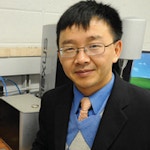An Energy-harvesting Building Facade
for Building Information System
Sign in and Register
Create an Account
Overview
Abstract
In order to reduce energy consumption throughout the whole life-cycle of buildings and increase the comfort performance of building sectors, an energy-harvesting building facade is explored by integrating a self-powered wireless sensing unit into the building facade. The demo self-powered wireless sensing unit presented is specially designed for a unitized window system, which is placed and sealed inside the window section and extracts energy from the ambient environment for its own power supply. By taking advantage of the excellent thermal break performance of modern window systems, ambient thermal energy from the temperature gradient across building facades is harvested via thermal electric generator. The harvested energy will be stored in rechargeable batteries and managed by an integrated circuit to power up sensors and wireless communication devices to transfer sensed data to the data server of the network, which will inform a building information system (BIS) for the optimal control of building environment.
Authors

Fangliang Chen, Ph.D., PE
Senior Structural Engineer
Schüco International KG
fchen@schuco-usa.com

Qiliang Lin, Ph.D.
Columbia University
Schüco USA
ql2241@columbia.edu

Tejav DeGanyar, Ph.D., PE
Directior
Schüco International KG
TDeGanyar@schuco-usa.com

Huiming Yin, Ph.D., PE,
Professor of Columbia University
hy2251@Columbia.edu
Introduction
The buildings sector is the largest consumer of electricity. It was reported that the buildings sector accounts for about 76% of electricity use and 40% of all U.S. primary energy
Access Restricted
TPWSN System Design
The architecture of a TPWSN is schematically drawn in Figure 1, with two major units: the energy harvesting and the wireless sensor network. The data from the TPWSN node will
Access Restricted
Energy Harvesting Unit
Energy Harvester
Generally, the thermal insulation is the key to quantify the performance of a window/façade system. The thermal bridging and infiltration losses shall be minimized as much as possible, to
Access Restricted
Wireless Sensor Network Unit
The energy harvested from the environment is majorly consumed via the wireless sensor network (WSN) unit, which is responsible for ambient environment monitoring, initial data processing, and wireless communication to
Access Restricted
System Integration and Performance Test
The testing configuration is demonstrated in Figure 8. The bottom of the window frame is immersed into the ice water for the cooling and the top is attached with a
Access Restricted
Conclusion
A self-powered wireless sensor network unit has been designed and tested inside a window frame, to provide a platform for the application of different sensors and processors for smart window
Access Restricted
Acknowledgements
The authors thank the technical support from Prof. Yi-Chung Chen from the Department of Electrical and Computer Engineering, Tennessee State University.
Rights and Permissions
[1] US Department of Energy, “Quadrennial Technology Review 2015-An Assessment of Energy Technologies and Research Opportunities, Chapter 5: Increasing Efficiency of Building Systems and Technologies,” US Department of Energy, 2015.
[2] M. Manic, D. Wijayasekara, K. Amarasinghe, and J. J. Rodriguez-Andina, “Building Energy Management Systems: The Age of Intelligent and Adaptive Buildings,” IEEE Ind. Electron. Mag., vol. 10, no. 1, pp. 25–39, Mar. 2016.
[3] M. A. Berawi, P. Miraj, M. S. Sayuti, and A. R. B. Berawi, “Improving building performance using smart building concept: Benefit cost ratio comparison,” AIP Conf. Proc., vol. 1903, no. 1, p. 030001, Nov. 2017.
[4] F. K. Shaikh and S. Zeadally, “Energy harvesting in wireless sensor networks: A comprehensive review,” Renew. Sustain. Energy Rev., vol. 55, pp. 1041–1054, 2016.